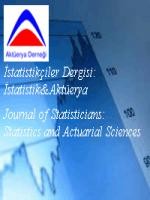Kasko sigortasında hasar nedenlerinin yarışan riskler regresyon modeli ile analizi
Bu çalışmanın altında yatan temel amaç; yaşam çözümlemesinde yarışan riskleri, aslında bir hayat dışı sigorta türü olan kasko sigortasına uygulamaktır. Bu amaca hizmet etmek için, 98.667 tane gözlemi kapsayan yedi tane açıklayıcı değişkeni içeren kapsamlı bir sigorta veri seti göz önünde bulundurulmuştur. Bu veri seti 2014 yılından gelmiş olup, özel bir hayat dışı sigorta şirketinden alınmıştır. Başarısızlığı etkileyen faktörler yarışan riskler regresyon modeli aracılığıyla ölçülmüştür. Birikimli etki fonksiyonunun tahminleri, her olası neden için ayrı ayrı elde edilmiştir. Buna ek olarak, nedenlerin karşılaştırmalı etkinliği uygun hasarların oluşmasıyla sonuçlanacak şekilde, yarışan riskler kullanılarak incelenmiştir.
Anahtar Kelimeler:
Yaşam çözümlemesi, Yarışan riskler regresyon modeli, Birikimli etki fonksiyonu, Kasko sigortası
An analysis of cause of loss in comprehensive insurance under competing risks regression model
The purpose underlying the main aim of the present study is to apply the competing risks of survival analysis upon the comprehensive insurance practices, which -in itself- is a non-life insurance type. To serve for the purpose, a detailed insurance data set comprising seven explanatory variables that encompass 98,667 observations was taken into consideration. This data set stemmed from 2014 and was obtained from a private non-life insurance company. Factors that determine unsuccessfulness were measured by means of competing risk regression model. For each probable cause, estimates of cumulative incidence function were obtained separately. Moreover, by employing competing risks, the comparative effectiveness of causes had been investigated which would result in creating appropriate damages.
Keywords:
Survival analysis, Competing risks regression model, Cumulative incidence function, Comprehensive insurance,
___
- [1] D. Karasoy, N. A. Tutkun, 2016, Yaşam Çzöümlemesi, Ankara: Nobel Press.
- [2] M. Pintilie, 2006, Competing risks: a practical perspective (Vol. 58), John Wiley & Sons.
- [3] M. L. Moeschberger, H. A. David, 1971, Life tests under competing causes of failure and the theory of competing risks, Biometrics 4, 909-933.
- [4] J. F. Carriere, 1994, Dependent decrement theory, Transactions of the Society of Actuaries, 46, 45-74.
- [5] A.S. MacDonald, 1997, An Actuarial Survey of Statistical Models for Decrement and Transition Data II: Competing Risks, Non-Parametric and Regression Models. Insurance Mathematics and Economics, 2(20), 142.
- [6] E.W. Frees, E. A. Valdez, 1998, Understanding relationships using copulas, North American Actuarial Journal 2, 1-25.
- [7] N. Keiding, C. Andersen, P. Fledelius, 1998, The Cox Regression Model for Claims Data m Non-Life Insurance. Astin Bulletin 28, 95-118.
- [8] G. L. Grunkemeier, R. Jin, M. J. Eijkemans, J. J. Takkenberg, 2007, Actual and actuarial probabilities of competing risks: apples and lemons, The Annals of Thoracic Surgery, 83, 1586-1592.
- [9] V. K. Kaishev, D. S. Dimitrova, S. Haberman, 2007, Modelling the joint distribution of competing risks survival times using copula functions, Insurance: Mathematics and Economics, 41, 339-361.
- [10] J. J. Dignam, Q. Zhang, M.N. Kocherginsky, 2012, The use and interpretation of competing risks regression models. Clinical Cancer Research, clincanres-2097.
- [11] F. Planchet, J. Tomas, 2016, Uncertainty on survival probabilities and solvency capital requirement: application to long-term care insurance. Scandinavian Actuarial Journal, 2016, 279-292.
- [12] M. Pintilie, 2011, An introduction to competing risks analysis, Revista Española de Cardiología (English Edition), 64, 599-605.
- [13] R.G. Gutierrez, 2010, Competing-risks regression, Stata Conference, Boston.
- [14] B. Haller, G. Schmidt, K. Ulm, 2013, Applying competing risks regression models: an overview. Lifetime data analysis, 19(1), 33-58.
- ISSN: 1308-0539
- Yayın Aralığı: Yılda 2 Sayı
- Başlangıç: 2008
- Yayıncı: Aktüerya Derneği
Sayıdaki Diğer Makaleler
Matris değişkenli Laplace dağılımı: Özellikleri ve parametre tahmini
Kasko sigortasında hasar nedenlerinin yarışan riskler regresyon modeli ile analizi
Uzunlamasına kısmi-sürekli veri için marjinalleştirilmiş çok seviyeli rastgele etkili bir model
